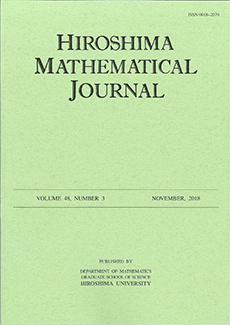Abstract
This paper is devoted to the existence and (in)stability of nonconstant steady-states in a system of a semilinear parabolic equation coupled to an ODE, which is a simplified version of a receptor-ligand model of pattern formation. In the neighborhood of a constant steady-state, we construct spatially heterogeneous steady-states by applying the bifurcation theory. We also study the structure of the spectrum of the linearized operator and show that bifurcating steady-states are unstable against high wave number disturbances. In addition, we consider the global behavior of the bifurcating branches of nonconstant steady-states. These are quite different from classical reaction-diffusion systems where all species diffuse.
Citation
Ying Li. Anna Marciniak-Czochra. Izumi Takagi. Boying Wu. "Bifurcation analysis of a diffusion-ODE model with Turing instability and hysteresis." Hiroshima Math. J. 47 (2) 217 - 247, July 2017. https://doi.org/10.32917/hmj/1499392826
Information




